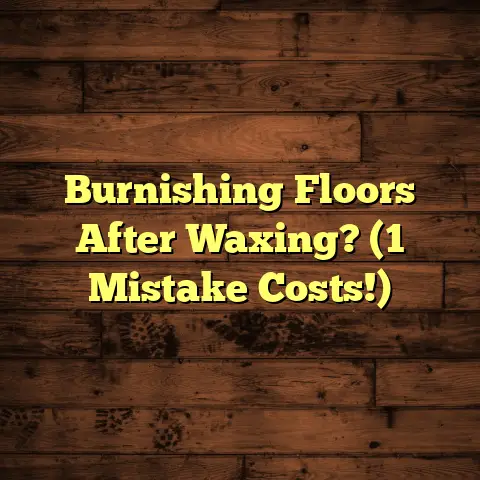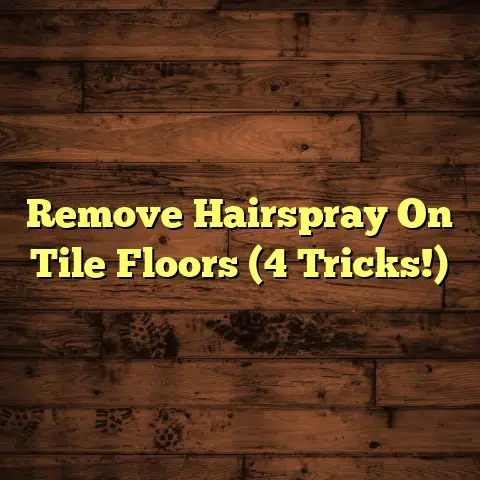Laminate Scratch Removal (7 Hacks!)
Ever had that moment? You know, the one where you’re admiring your freshly decorated living room, maybe after a long day of work.
You step back, feeling proud, and then BAM! Your eyes land on a series of ugly scratches marring your beautiful laminate flooring. Ugh!
I’ve been there, and I know that feeling. It’s a mix of disappointment, frustration, and maybe even a little panic. How did this happen? Is my floor ruined? Do I need to replace the whole thing?
As a flooring contractor with over 15 years in the game, I’ve seen it all. And I can tell you that scratches on laminate are super common.
Think about it: furniture being moved, pets with playful claws, those stilettos your friend wore to your last party… life happens!
But don’t despair! The good news is that you don’t have to live with those scratches, and you definitely don’t need to rip up your entire floor.
I’m going to share seven effective hacks that I’ve used over the years to remove or significantly minimize those unsightly blemishes.
Ready to reclaim the beauty of your floors? Let’s dive in!
1. Understanding Laminate Flooring
Before we get into the hacks, let’s quickly cover what laminate flooring actually is.
It’s not real wood, but it’s designed to look like real wood (or stone, or tile, depending on the style).
Laminate is a multi-layer synthetic flooring product fused together through a lamination process.
Typically, it consists of these layers:
-
Wear Layer: This is the top layer, a transparent coating that protects the floor from scratches, stains, and fading.
-
Decorative Layer: This is the layer that gives the laminate its appearance – the wood grain, the stone pattern, etc. It’s a high-resolution printed image.
-
Core Layer: This is the main body of the laminate, usually made of high-density fiberboard (HDF) or medium-density fiberboard (MDF). It provides stability and impact resistance.
-
Backing Layer: This bottom layer provides a moisture barrier and helps to balance the floor.
Laminate’s popularity stems from its affordability, durability (to a point!), and ease of installation.
It’s a great option for homeowners who want the look of hardwood without the high cost and demanding maintenance.
However, that wear layer, while protective, can be scratched. And because it’s not solid wood, you can’t just sand down the entire surface like you would with hardwood. That’s why these hacks are so important!
2. Hack #1: DIY Scratch Repair Kits
Okay, let’s get to the good stuff!
My first recommendation is to try a DIY scratch repair kit. These kits are readily available at most hardware stores and online retailers.
They typically include a variety of items, such as:
-
Fill Sticks or Wax Sticks: These are colored wax sticks that you can use to fill in deeper scratches.
-
Touch-Up Markers: These markers are designed to match the color of your flooring and cover up superficial scratches.
-
Putty or Filler: Some kits include a putty or filler that can be used to repair chips or gouges.
-
Applicator Tools: These might include small spatulas, cloths, or sandpaper.
How to Use a Scratch Repair Kit:
-
Clean the Area: Before you start, make sure the scratched area is clean and free of any debris. Use a damp cloth to wipe away any dirt or dust.
-
Choose the Right Color: This is crucial! You want to select a fill stick or marker that closely matches the color of your laminate.
Most kits come with a range of colors that you can mix and match to get the perfect shade.
Pro Tip: Test the color in an inconspicuous area first to make sure it blends in well.
-
Apply the Filler: If you’re using a fill stick, soften the tip slightly with your fingers.
Then, gently rub the stick over the scratch, pressing down firmly to fill it in.
For deeper scratches, you may need to apply several layers.
-
Remove Excess Filler: Use a plastic putty knife or an old credit card to scrape away any excess filler. Hold the tool at a slight angle to avoid removing too much.
-
Blend the Repair: Use a soft cloth to buff the area and blend the repair into the surrounding flooring.
If you’re using a touch-up marker, simply apply it to the scratch and let it dry.
-
Clean Up: Once the repair is dry, clean the area with a damp cloth to remove any residue.
I’ve found that these kits work best for minor to moderate scratches. They’re relatively easy to use and can provide a noticeable improvement.
3. Hack #2: Using a Blend of Crayons and Oil
This is one of my favorite DIY hacks because it’s so simple and effective. All you need are crayons and a little bit of oil!
The idea here is to create a custom-colored filler that matches your flooring perfectly.
Here’s how it works:
-
Gather Your Supplies: You’ll need a few crayons that are close to the color of your laminate flooring.
You’ll also need a small amount of mineral oil, baby oil, or even cooking oil.
A heat source like a lighter or a candle, and something to mix with, like a toothpick or a small spatula.
-
Match the Color: Experiment with different crayon colors to find the best match for your flooring.
You can even mix different colors together to create a custom blend.
Pro Tip: It’s always better to go a shade lighter than a shade darker.
-
Melt the Crayon: Carefully melt a small amount of the crayon using a lighter or a candle.
Be careful not to overheat the crayon, as it can catch fire.
-
Mix in the Oil: Add a drop or two of oil to the melted crayon. The oil will help to soften the crayon and make it easier to apply.
Mix well until you have a smooth, creamy paste.
-
Apply the Filler: Use a toothpick or a small spatula to apply the crayon mixture to the scratch.
Press down firmly to fill in the scratch completely.
-
Remove Excess Filler: Use a plastic putty knife or an old credit card to scrape away any excess filler.
Hold the tool at a slight angle to avoid removing too much.
-
Blend the Repair: Use a soft cloth to buff the area and blend the repair into the surrounding flooring.
I’ve used this hack on countless jobs, and it’s amazing how well it works.
The crayon fills in the scratch, and the oil helps to create a smooth, seamless finish.
4. Hack #3: The Magic of Coconut Oil
Coconut oil isn’t just for cooking or skincare – it can also work wonders on scratched laminate flooring!
Coconut oil has natural moisturizing and polishing properties that can help to minimize the appearance of scratches and restore shine.
Here’s how to use it:
-
Clean the Area: As always, start by cleaning the scratched area with a damp cloth.
-
Apply Coconut Oil: Apply a small amount of coconut oil to a soft cloth.
-
Buff the Scratch: Gently rub the cloth over the scratch in a circular motion. Apply light to moderate pressure.
-
Let it Sit: Allow the coconut oil to sit on the scratch for about 5-10 minutes.
-
Buff Again: Use a clean, dry cloth to buff the area again. This will remove any excess oil and bring out the shine.
I’ve found that coconut oil works best on light scratches and scuff marks. It won’t fill in deep scratches, but it can definitely help to make them less noticeable.
Plus, it leaves your floor smelling amazing!
5. Hack #4: Vinegar and Olive Oil Solution
This is another great natural remedy that you probably already have in your pantry.
Vinegar and olive oil have cleaning and restorative properties that can help to minimize the appearance of scratches and restore shine.
Here’s the recipe:
- 1/2 cup of white vinegar
- 1/2 cup of olive oil
Instructions:
-
Mix the Solution: Combine the vinegar and olive oil in a spray bottle. Shake well to mix.
-
Spray the Area: Lightly spray the solution onto the scratched area.
-
Wipe and Buff: Use a soft cloth to wipe the area, following the grain of the laminate.
Then, use a clean, dry cloth to buff the area and bring out the shine.
I’ve found that this solution works best on light scratches and scuff marks.
The vinegar helps to clean the surface, while the olive oil helps to moisturize and protect the laminate.
6. Hack #5: Using a Simple Walnut
Yes, you read that right! A walnut can actually help to fill in scratches on laminate flooring.
The natural oils in the walnut help to darken the scratch and make it less noticeable.
Here’s how to do it:
-
Find a Walnut: Grab a walnut from your pantry. Make sure it’s a fresh walnut, as older walnuts may not have as much oil.
-
Crack it Open: Crack the walnut open and remove the nutmeat.
-
Rub the Scratch: Rub the nutmeat over the scratch, applying moderate pressure.
The oils from the walnut will start to transfer to the laminate.
-
Let it Sit: Allow the oil to sit on the scratch for about 5-10 minutes.
-
Buff the Area: Use a soft cloth to buff the area and remove any excess oil.
I know it sounds crazy, but this hack actually works!
The walnut oil fills in the scratch and helps to blend it in with the surrounding flooring.
Pro Tip: This works best on darker laminate floors.
7. Hack #6: Sanding Down Deeper Scratches
Okay, this hack is a little more advanced, and it’s only appropriate for deeper scratches that can’t be fixed with the other methods.
Sanding laminate flooring can be risky, as you can easily damage the wear layer and ruin the floor.
However, if you’re careful and follow these steps, you can successfully sand down deeper scratches.
Here’s what you’ll need:
-
Fine-Grit Sandpaper: You’ll need sandpaper with a very fine grit, such as 320-grit or 400-grit.
-
Sanding Block: A sanding block will help you to apply even pressure.
-
Dust Mask: It’s important to wear a dust mask to protect your lungs from the sanding dust.
-
Vacuum Cleaner: You’ll need a vacuum cleaner to clean up the sanding dust.
-
Laminate Repair Kit: You’ll need a laminate repair kit to fill in the sanded area.
Here’s how to do it:
-
Clean the Area: As always, start by cleaning the scratched area with a damp cloth.
-
Sand the Scratch: Wrap the sandpaper around the sanding block and gently sand the scratch.
Use light, even pressure and sand in the direction of the grain.
Be careful not to sand too much, as you can easily damage the wear layer.
-
Vacuum the Dust: Use a vacuum cleaner to clean up the sanding dust.
-
Fill the Area: Use a laminate repair kit to fill in the sanded area. Follow the instructions on the kit.
-
Blend the Repair: Use a soft cloth to buff the area and blend the repair into the surrounding flooring.
I only recommend this hack as a last resort. If you’re not comfortable sanding your laminate flooring, it’s best to call a professional.
8. Hack #7: Professional Restoration Kits
If you’ve tried the DIY methods and you’re still not happy with the results, it might be time to consider a professional restoration kit.
These kits are more expensive than the DIY options, but they typically include more advanced tools and materials that can provide better results.
For example, some kits include:
-
Color-Matching Putty: This putty is designed to match the color of your flooring perfectly.
-
Heat Gun: A heat gun can be used to soften the putty and make it easier to apply.
-
Texturing Tools: These tools can be used to recreate the texture of your laminate flooring.
DIY vs. Professional Kits:
Here’s a quick comparison:
| Feature | DIY Methods | Professional Kits |
|---|---|---|
| Cost | Lower | Higher |
| Skill Level | Beginner | Intermediate to Advanced |
| Results | Good for minor to moderate scratches | Better results for deeper scratches and chips |
| Time Investment | Less | More |
Ultimately, the best option for you will depend on your budget, your skill level, and the severity of the scratches.
If you’re not sure which option is right for you, I recommend consulting with a flooring professional.
Conclusion
So, there you have it – seven effective hacks for removing scratches from your laminate flooring!
Remember, scratches are a common nuisance, but they’re not the end of the world.
With a little bit of effort and the right tools, you can restore your flooring and reclaim the beauty of your home.
Don’t be afraid to experiment and try different methods to see what works best for you.
And if you’re ever in doubt, don’t hesitate to call a professional.
Now go forth and conquer those scratches! Your floors (and your sanity) will thank you.





